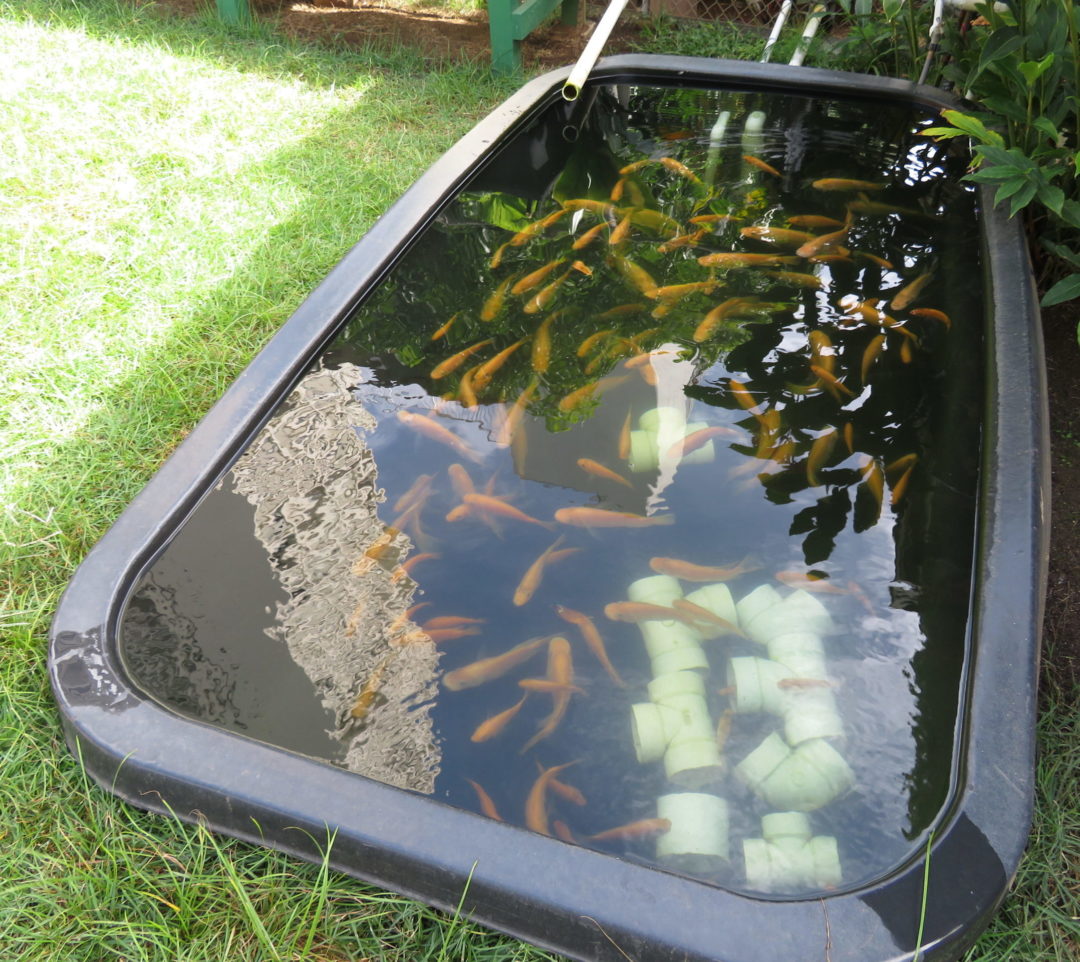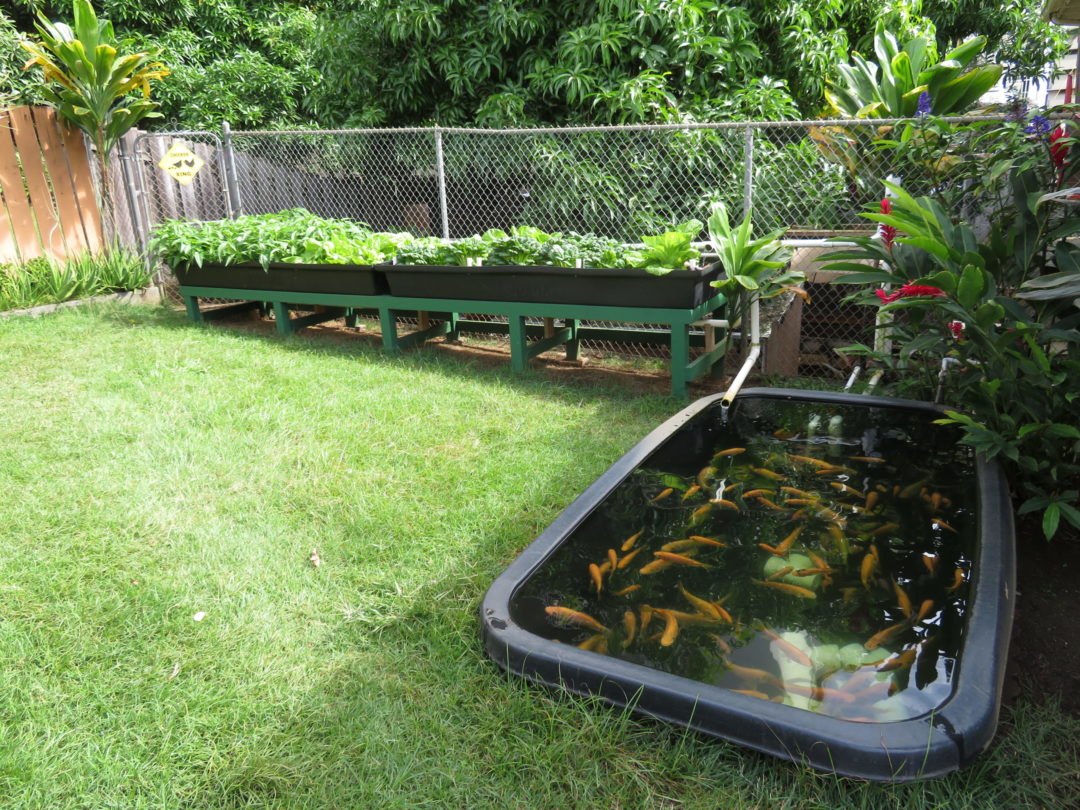Aquaponics
Aquaponics is a hybridization of Aquaculture and Hydroponics.
Aquaculture

Aqua-culture (aquatic cultivation), has been practiced by many societies around the world throughout history. Methods varie, depending on the needs and available resources for each situation. People have used cages, ponds, open water pens, tanks, and artificial pools to support their production. And prior to widespread commercial adoption, most aquaculture systems where designed to provide subsistence production for communities, though this has been changing rapidly as countries continue to invest in commercial and industrial program, to compensate for growing demand and diminishing resources. Most aquaculture programs are designed to produce fish, but it is also employed in the cultivation of shellfish, muscles, seaweed, algae, and even corals.
Raising fish in controlled conditions requires a large investment of time and labor. But it can be advantageous in that it provides a level of consistency and predictability which offsets the volatility and risk inherent in being dependent on fishing and gathering.
Creating artificial systems to mitigate variables like predation, and competition for food, means that people have to take care to incorporate methods to monitor and manage associated factors like disease, reproduction, and pollution which would otherwise be regulated by forces in the natural environment.
Water quality is a particularly important variable to manage in aquaculture. Waste products, and organic matter have to be removed at a rate faster then they are produced, and fresh oxygenated water has to be introduced faster than it is being consumed.
In a natural environment this would normally be achieved through the food chain, diffusion, or current flow. But in a closed or restricted system, artificial methods like filtration, flushing, or chemical treatment have to be employed to compensate.
Pro:
- reliable source of fish protein
- long term storage of fresh fish available year round
Cons:
- fish need to be fed since they are not able to forage on their own
- needs regular source of fresh water
- physical waste needs to be removed
- biochemistry needs to be managed
Hydroponics
Hydroponics is a subset of Hydroculture (water cultivation), and is the practice of growing plants without soil. In hydroponics artificial substitutes are employed to provide for the nutrition, hydration, and mechanical needs of the plant.
note:
Before we can understand why we would want to grow plants without soil, we have to understand what soil is doing in the first place.
Soil
In my opinion, there really is no comparable substitute for healthy well balanced soil.
Soil is not a static substance, as much as it is a complex and dynamic biome.
Essential qualities of soil.
- Biochemically hospitable as environment for a multitude of organisms and physical interactions, where simple organic compounds and inorganic materials are broken down and then synthesized into new resources for complex biological processes.
- A rigid substrate, that provides mechanical support for plant structures.
- Semi-permeable medium with the ability to transfer and exchange gas and liquids between the atmosphere and the subterranean environment through diffusion and capillary activity.
- Absorbent enough to retain moisture as temporary reservoir for hydration and thermal regulation.

For most applications, soil is an ideal medium to grow plants and vegetables.
That being said, cultivation in soil is a resource intensive activity.
Soil based agriculture needs a lot of space, both in terms of two dimensional surface area and three dimensional volume to allow for adequate drainage.
Furthermore, soil is also both a perishable and consumable resource once it has been removed from the environment where it was generated. Bacteria will become dormant as moisture is lost. Insects and worms will migrate or die if conditions become inhospitable. Minerals and compounds will deplete as they are taken up by the vegetation.
Soil as a nourishing biome requires interaction with a larger environment to maintain its viability over time. It can serve as a temporary store of nutrient resources and a foundational component for growth, but will degrade over time if not reestablished in a well balanced ecosystem.
And perhaps most importantly, soil based agriculture consumes an enormous amount of water, since water used in irrigation can only be used once.
These limitations constitute significant obstacles to the application of soil in closed environments such as containers or interior spaces where the capacity for drainage and ventilation are restricted.
Fertilizers can be amended to the soil to replenish nutrients, but without the natural activity of worms, insects and bacteria, to fully break the amendments down, the quality of the soil will be substandard. In fact the same biological properties that make soil so effective as a growth medium are major liabilities in enclosed spaces where insects, rot, mold, and spores can be detrimental to health and air quality.
Soil works best when you have access to large open spaces, are able to produce your own compost, or are willing to regularly purchase soil ammendments to maintein your soil quality.
Hydroponics

This brings us back to Hydroponics. Again, in my opinion, hydroponics is not superior to soil based agriculture, but in some situations it is more practical, and sometime even preferable.
Hydroponics uses biologically inert materials to suspend, or submerge plants in a nutrient solution. In most cases the nutrients are supplied in a liquid wash, but they can also be applied in the form of a mist, bath or gelatin if the situation requires.
A major advantage of hydroponics is that they only require enough space to ensure that the roots obtain adequate exposure to the solution. This means that plants can be stacked vertically or chained horizontally to make the best use of the available space.
Most hydroponic systems operate in a closed loop where the nutrient solution is retained at the end of the cycle for recirculation. Because hydroponic systems are highly oversimplified, they lack biological diversity and have less opportunity for biological regulation, so care has to be taken to monitor the chemical composition of the solution.
Pros:
- produce fresh vegetables
- highly compact efficient use of space
- efficient use of water as resources are recovered and reused multiple times
- functions independently from the larger environment
- can be deployed in confined or limited spaces
Cons:
- requires external source of nutrients
- requires reserculation of nutrient solution
- requires regulation of solution content
Aquaponics
Aquaponics combines aquaculture and hydroponics together in a way that the deficiencies of each system is used as a resource for the other.
Solution
- aquaculture needs a regular source of fresh water
- hydroponics requires reserculation of solution
Effluent is pumped out of the fish tank and into the hydroponic grow bed where it is filtered through the medium before returning back to the aquaponic system.
Ebb and flow systems provide continious circulation and biofiltration between systems
Solution
- aquaculture fish waste needs to be removed
- hydroponics requires an external source of nutrients
Silt and soft waste is broken down, by aggitaion, UV exposure, and microorganisms (worms) in the grow bed, into simpler compounds like Ammonia (NH3).
Aquaponic effluent is used as a renewable source of hydroponic fertilizer.
Solution
- aquaculture biochemistry needs to be managed
- hydroponic solution requires regulation of its chemical composition
Nitrifying bacteria in the grow bed consume the Ammonia (NH3), which is toxic to fish, and create Nitrites (NO2) as a waste product.
These Nitrites (NO2), which are also toxic to fish, are then consumed by a second class of nitrifying bacteria which produce Nitrates (NO3) as a waste product.
Plants then remove the Nitrates (NO3) for use in photosynthesis and cell production.
Ammoni levels in the grow bed and fish tank are not allowed to build up as free NH3 is quickly converted into NO3 for the plants.
Chemical equilibrium self stabilizes through biofiltration and bacterial nitrification.

Summery
Aquaponics Inputs:
- feed for the fish
- regular maintenance
Aquaponic Outputs:
- the ability to produce fresh vegetables
- the ability to produce a regular source of protein
- long term storage of fresh fish
- compact use of space
- efficient use of water
- functions independently from the larger environment
- can be deployed in confined or limited spaces
- biochemicaly self regulating
- superior growth rates at high densities due to constant supply of nitrates